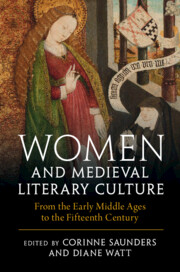Book contents
- Women and Medieval Literary Culture
- Women and Medieval Literary Culture
- Copyright page
- Contents
- Illustrations
- Contributors
- Acknowledgements
- Introduction
- I Patrons, Owners, Writers, and Readers in England and Europe
- II Circles and Communities in England
- III Health, Conduct, and Knowledge
- IV Genre and Gender
- V Women as Authors
- Chapter 18 Marie de France
- Chapter 19 Julian of Norwich
- Chapter 20 The Communities of The Book of Margery Kempe
- Chapter 21 Christine de Pizan
- Chapter 22 Beyond Borders
- General Index
- Index of Manuscripts
- References
Chapter 18 - Marie de France
Identity and Authorship in Translation
from V - Women as Authors
Published online by Cambridge University Press: 28 July 2023
- Women and Medieval Literary Culture
- Women and Medieval Literary Culture
- Copyright page
- Contents
- Illustrations
- Contributors
- Acknowledgements
- Introduction
- I Patrons, Owners, Writers, and Readers in England and Europe
- II Circles and Communities in England
- III Health, Conduct, and Knowledge
- IV Genre and Gender
- V Women as Authors
- Chapter 18 Marie de France
- Chapter 19 Julian of Norwich
- Chapter 20 The Communities of The Book of Margery Kempe
- Chapter 21 Christine de Pizan
- Chapter 22 Beyond Borders
- General Index
- Index of Manuscripts
- References
Summary
This essay focuses on the writer today known as ߢMarie de Franceߣ, who is among the earliest named women authors in French and England. Yet, we cannot be certain the same author composed all of the Anglo-Norman French works conventionally ascribed to her. Campbell asks what it might it mean to see ߢMarieߣ less as an exceptional female author and more as an example of a multilingual culture of womenߣs writing and translation. A critical focus on Marie as unique, Campbell argues, downplays the reliance of the works attributed to her on translation, and their connection to an Anglo-Norman literary culture in which women were active participants. The essay also explores the networks and translations depicted within Marieߣs works, and the ways in which these comment on the processes of composition and transmission to which translation is central. Characterised by collaboration, translation, intertextuality, and multilingualism, womenߣs literary culture is shown to challenge traditional notions of authorship.
Keywords
- Type
- Chapter
- Information
- Women and Medieval Literary CultureFrom the Early Middle Ages to the Fifteenth Century, pp. 379 - 399Publisher: Cambridge University PressPrint publication year: 2023

